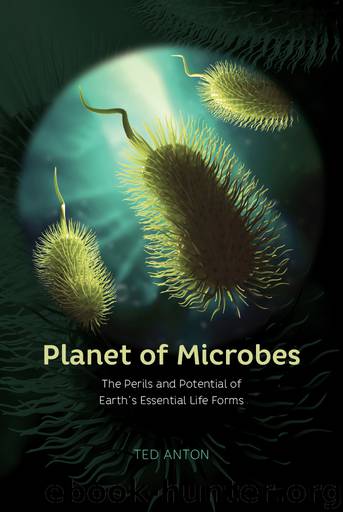Planet of Microbes by Ted Anton

Author:Ted Anton [Anton, Ted]
Language: eng
Format: epub
ISBN: 978-0-226-35413-2
Publisher: University of Chicago Press
Published: 2017-10-05T04:00:00+00:00
A new world
At sunset the nocturnal squid awakens and imbibes its fresh set of bacteria, whose whitish light hides it from predators. But the same bacteria’s cousins cause cholera, pertussis, and gonorrhea. The strange, compelling message of microbe-animal symbiosis was that some of the same molecular signals that caused illness could also enhance life.
Commercial and academic interest in the marine microbiome intensified. Berlin-based Cyano Biotech and other companies studied lake and ocean cyanobacteria, the culprits in toxic blooms, as a source of new healthcare and medicinal products. Madrid-based PharmaMar sought medicines from deep-sea relatives of streptomycetes. Reykjavik-based Matis sought to understand the microbial diversity of Iceland’s hydrothermal vents, while Norwegian scientists studied ocean microbes’ potential for degrading oil spills. On the manmade side, the Chicago-based Shedd Aquarium’s Marine Microbiome Project made the first global effort to catalog the microbiomes of sea mammals and fish in aquariums. “I think about water differently now,” said Chrissy Cabay, Shedd Project Manager. “We live on an aquarium planet.”
On land, some companies were making use of terrestrial bioluminescence for cheap lighting and road signage. The nerve-deadening food-poisoning toxin secreted by Clostridium botulinum made the key ingredient of high-priced Botox treatments.
The concerted effort of McFall-Ngai and others helped bring the complexities of the microbiome to the center stage of biology and medicine. By the time McFall-Ngai was nearly done teaching in a professorship at the University of Wisconsin, more studies were suggesting that some forms of depression, obesity, and attention-deficit hyperactivity disorder (ADHD) were linked to deficits in our microbes, perhaps caused by the overuse of antibiotics. The human gut microbiome calibrated our burning of calories and milk metabolism, and also served as a “tuning fork,” one study showed, of a child’s developing immune system. Inflammatory bowel disease and Crohn’s disease, both highly dangerous and rising in incidence, were correlated with microbial deficits. Type 1 diabetes was linked to exposure to an Enterovirus. According to the Max Planck Institute researcher Kirstin Berer, even multiple sclerosis, a disease in which the gut microbes seem to turn against its nerve cells, might be addressed by a simple transplant of microbes from a healthy person.
Recurrent Clostridium difficile infections, inflammatory bowel disease, and Crohn’s disease all defied normal antibiotic, radiation, and antiviral treatments. As a last resort, doctors took to fecal transplants from healthy donors, and achieved remarkable results for some patients. A fecal transplant is a procedure by which fecal matter is taken from a tested donor, diluted in saline, strained, and placed in a patient by colonoscopy or enema. The purpose is to replace good bacteria that have been killed or suppressed, usually by antibiotics, allowing pathogens like Clostridium difficile to overpopulate the gut. The American Society for Microbiology convened a “Bugs as Drugs” colloquium to devise ways to employ microbes themselves in the fights against cancer and antibiotic resistance. Some of these included microbes to tamp down the immune response, for those gastrointestinal diseases, or pathogenic microbes to ramp it up, as a way of attacking cancer tumors, or to augment radiation or other conventional antibiotic drug treatments.
Download
This site does not store any files on its server. We only index and link to content provided by other sites. Please contact the content providers to delete copyright contents if any and email us, we'll remove relevant links or contents immediately.
Sapiens: A Brief History of Humankind by Yuval Noah Harari(14216)
Sapiens by Yuval Noah Harari(5281)
Pale Blue Dot by Carl Sagan(4886)
Homo Deus: A Brief History of Tomorrow by Yuval Noah Harari(4801)
Livewired by David Eagleman(3663)
Origin Story: A Big History of Everything by David Christian(3632)
Brief Answers to the Big Questions by Stephen Hawking(3358)
Inferior by Angela Saini(3260)
Origin Story by David Christian(3133)
Signature in the Cell: DNA and the Evidence for Intelligent Design by Stephen C. Meyer(3055)
The Gene: An Intimate History by Siddhartha Mukherjee(3029)
The Evolution of Beauty by Richard O. Prum(2925)
Aliens by Jim Al-Khalili(2776)
How The Mind Works by Steven Pinker(2714)
A Short History of Nearly Everything by Bryson Bill(2616)
Sex at Dawn: The Prehistoric Origins of Modern Sexuality by Ryan Christopher(2472)
From Bacteria to Bach and Back by Daniel C. Dennett(2432)
Endless Forms Most Beautiful by Sean B. Carroll(2415)
Who We Are and How We Got Here by David Reich(2385)
